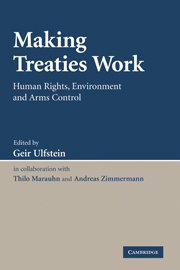Book contents
- Frontmatter
- Contents
- Preface and acknowledgments
- Notes on the contributors
- Table of cases
- Table of treaties and other international instruments
- INTRODUCTION
- PART I INTERNATIONAL HUMAN RIGHTS
- PART II INTERNATIONAL ENVIRONMENTAL LAW
- PART III INTERNATIONAL ARMS CONTROL
- 10 Dispute resolution, compliance control and enforcement of international arms control law
- 11 The Convention on the Prohibition of the Development, Production, Stockpiling and Use of Chemical Weapons and on their Destruction (Chemical Weapons Convention)
- 12 The Treaty on the Non-Proliferation of Nuclear Weapons (NPT) and the IAEA Safeguards Agreements
- 13 The Convention on the Prohibition of the Use, Stockpiling, Production and Transfer of Anti-Personnel Mines and on their Destruction (Ottawa Convention)
- GENERAL COMMENTS
- Index
11 - The Convention on the Prohibition of the Development, Production, Stockpiling and Use of Chemical Weapons and on their Destruction (Chemical Weapons Convention)
Published online by Cambridge University Press: 05 September 2009
- Frontmatter
- Contents
- Preface and acknowledgments
- Notes on the contributors
- Table of cases
- Table of treaties and other international instruments
- INTRODUCTION
- PART I INTERNATIONAL HUMAN RIGHTS
- PART II INTERNATIONAL ENVIRONMENTAL LAW
- PART III INTERNATIONAL ARMS CONTROL
- 10 Dispute resolution, compliance control and enforcement of international arms control law
- 11 The Convention on the Prohibition of the Development, Production, Stockpiling and Use of Chemical Weapons and on their Destruction (Chemical Weapons Convention)
- 12 The Treaty on the Non-Proliferation of Nuclear Weapons (NPT) and the IAEA Safeguards Agreements
- 13 The Convention on the Prohibition of the Use, Stockpiling, Production and Transfer of Anti-Personnel Mines and on their Destruction (Ottawa Convention)
- GENERAL COMMENTS
- Index
Summary
Introduction
The 1993 Chemical Weapons Convention (CWC) is a true disarmament instrument: in adhering to the treaty all States parties have undertaken to eliminate this category of weapon by destroying all of their existing stockpiles and related production facilities and by taking positive measures to prevent any new proliferation. The Convention has achieved nearly universal adherence, with 179 States parties as of 1 October 2006 and an additional seven signatory States. The CWC contains the most intrusive verification regime established so far. Initially lauded as the model for future arms control and disarmament agreements, after nine years of implementation it remains an important anomaly in the current international political climate.
Expanding upon the one-page 1925 Geneva Protocol, which had effectively banned only the first-use of chemical weapons, the CWC comprises more than 200 pages prescribing that States parties shall never, under any circumstances: (a) develop, produce, otherwise acquire, stockpile, retain or use chemical weapons, or transfer them directly or indirectly to anyone; (b) engage in any military preparations to use them; or (c) assist, encourage or induce, in anyway, anyone to engage in any activity prohibited to a CWC State party. States parties are under the obligation to destroy all chemical weapons they own, possess, have under their control or have abandoned elsewhere, as well as the production facilities related to them. To close a near loophole, the CWC defines riot control agents and bans their use as a method of warfare.
- Type
- Chapter
- Information
- Making Treaties WorkHuman Rights, Environment and Arms Control, pp. 273 - 300Publisher: Cambridge University PressPrint publication year: 2007
- 1
- Cited by



